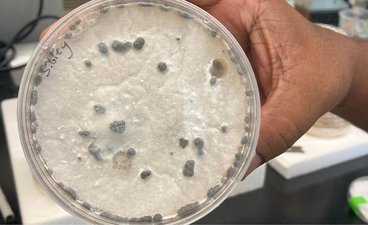Faculty member Dr. Ashish Ranjan and his lab are determined to grow healthy soybean crops with natural resistance to white mold fungus, allowing farmers to use fewer chemical treatments in their fields.
Sclerotinia sclerotiorum, or white mold, is a fungal pathogen that harms more than 400 plant species, including many major economically important global crops. Specifically, it was ranked the second most destructive American soybean disease in 2021 (report from Crop protection network 2022). Soybean plants lack strong resistance to white mold, so applying fungicide treatments is currently the most effective tool available to farmers. But fungicides have drawbacks: like other chemical interventions, they negatively impact soil, water, and human health and lead to the selection of fungicide-resistant pathogens along with the time and money they cost farmers, making them far from an ideal solution.

Harnessing the power of soybeans' genes to breed white mold resistance starts with getting to know them on a molecular level. The Ranjan lab has identified a few candidate genes that could play a crucial role in soybean resistance to Sclerotinia sclerotiorum. Currently, they are using molecular biology tools, genetics, and biochemical techniques to characterize their key functions. Greenhouse and field trials will bring comprehensive information about the resistance phenotype and germplasm targets, allowing for new genetic resources and breeding soy crops with healthy yield and increased white mold resistance.
Ranjan is joined in his research by research scientist Grace Anderson, MS student Nick Talmo, and undergraduate researchers Kristen Lerohl and Grace Petzold. Robert Stupar, a soybean molecular geneticist of the UMN Department of Agronomy and Plant Genetics, is collaborating to bioengineer soy for crucial genes. The USDA’s National Sclerotinia Initiative (NSI) funded the research.
